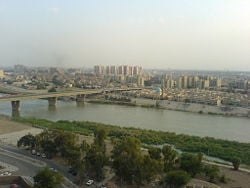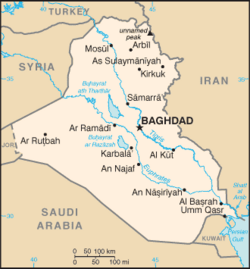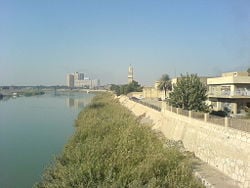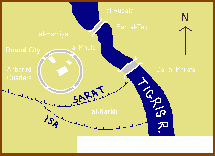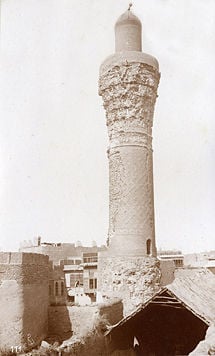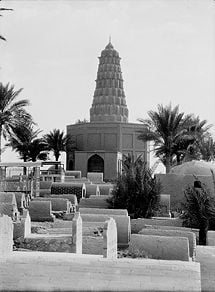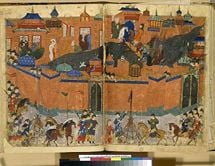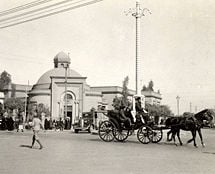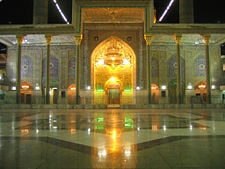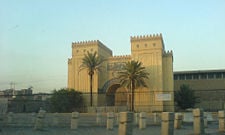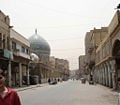Baghdad
| Baghdad | |
| — City — | |
| بغداد Baġdād | |
| General view of the north-western part of Baghdad city across the Tigris, 2006. | |
| The location of Baghdad within Iraq. | |
| Coordinates: {{#invoke:Coordinates|coord}}{{#coordinates:33|20|00|N|44|26|00|E| | |
|---|---|
| name= }} | |
| Country | |
| Province | Baghdad |
| Established | 762 C.E. |
| Founder | Abu Jafar al-Mansour |
| Government | |
| - Type | Mayor-council |
| - Mayor | Saber Nabet Al-Essawi |
| Area | |
| - Total | 2,260.2 km² (872.7 sq mi) |
| Elevation | 34 m (112 ft) |
| Population (2011)[1][2] | |
| - Total | 7,216,040 |
| Time zone | Arabia Standard Time (UTC+3) |
| - Summer (DST) | No DST (UTC) |
Baghdad (Arabic: بغداد Baġdād) is the capital of Iraq and of Baghdad Governorate, which it is also coterminous with. With a municipal population estimated at 7,000,000, it is the largest city in Iraq and the second-largest city in the Arab World (after Cairo).
Located on the Tigris River, the city dates back to at least the eighth century, with some evidence of its existence in pre-Islamic times. With a name meaning "God's gift," or “City of Peace,” Baghdad was a hub of learning and commerce in the eighth century, as the capital of the Abbasid Islamic empire. The city was sacked by the Mongols, it stagnated under Ottoman control, it prospered during the 1970s, but it has been a center of violent conflict since 2003, because of the ongoing Iraq War.
Iraq, in 2008, was considered a developing nation that was the focus of increased attention from the West as a result of a United States led invasion in 2003 and the ensuing turmoil. While its proven oil reserves of 112 billion barrels is one of the largest in the world, second only to Saudi Arabia, the United States Department of Energy estimates that up to 90 percent of the country's oil resources remain unexplored. The prospect for prosperity is high once peace is attained.
Geography
The most reliable and most widely accepted view of the etymology of the name "Baghdad" is that it is a Middle Persian compound of Bag "god" + dād "given," translating to "god-given" or "God's gift," whence Modern Persian Baɣdād. The name is pre-Islamic and the origins are unclear. During its golden age, the city was known as “Madinat as-Salam,” or “City of Peace.”
The city is located on a vast alluvial plain, 112 feet (34 meters) above sea level. The Tigris splits Baghdad in half, with the Eastern part called Risafa and the Western half known as Karkh. The land on which the city is built is almost entirely flat and low-lying, being of alluvial origin due to the periodic large floods which have occurred on the river. Completion of a dam on the Tigris at Samarra to the north, in 1956, stopped flooding.
Baghdad has a hot arid climate. In the summer from June to August, the average maximum temperature is as high as 111°F (44°C) accompanied by blazing sunshine. Though the humidity is very low (usually under 10 percent) due to Baghdad's distance from the marshy Persian Gulf, dust storms from the deserts to the west are normal. In the winter, from December to February, Baghdad has maximum temperatures averaging 59°F to 61°F (15°C to 16°C). The average January minimum is around 39°F (4°C) but temperatures below 32°F (0°C) are not uncommon during this season.
Annual rainfall, almost entirely confined to the period from November to March, averages around 5.5 inches (140 mm) but has been as high as 23 inches (575 mm) and as low as less than one inch (23 mm). On January 11, 2008, light snow fell across Baghdad for the first time in memory.
The land area of the city was 283.4 square miles (734 square kilometers) in 2006.
History
Foundation
Although a city of Baghdad is mentioned in pre-Islamic texts, including the Talmud, the city of Baghdad dates from 764 C.E., when the Abbasid caliph Abu Ja'far Al-Mansur founded the city. Mansur believed that Baghdad was the perfect city to be the capital of the Islamic empire. Baghdad's location was on a trade route for the Khurasans where caravans met and traded. The area had abundant water and a healthy climate. The goal was to replace Harran as the seat of the caliphal government. The site of the more ancient city of Babylon, deserted since the second century B.C.E., is located about 55 miles (85 kilometers) to the south.
Al-Mansur's city—Madīnat al-Salām (“City of Peace”)—was built within circular walls and eventually came to be called “the Round City.” Designed as a circle about one mile (2km) in diameter, it had three concentric walls. The original design shows a ring of residential and commercial structures along the inside of the city walls, but the final construction added another ring, inside the first. A mosque, and headquarters for guards, were located in the center of the city. Four main roads led from the caliph’s palace and the grand mosque at the center to various parts of the empire. The ancient Sasanian city of Gur/Firouzabad is nearly identical in its circular design, radiating avenues, and the government buildings and temples at the center of the city.
Center of learning
Baghdad came into its prime about 800 C.E., during the reign of the caliph Harun al-Rashid, when the streets were paved with a tar substance. Baghdad became a hub of learning and commerce. The House of Wisdom was an establishment dedicated to the translation of Greek, Middle Persian, and Syriac works. The Barmakids, a noble Persian Abbasid family, brought scholars from the nearby Academy of Gundishapur, thus introducing Greek and Indian science into the Arabic world. Baghdad was likely the largest city in the world until the 930s, when it was tied by Córdoba. Several estimates suggest that the city contained over a million inhabitants at its peak. A portion of the population of Baghdad originated in Iran, especially from Khorasan. Many of legendary Persian queen Scheherazade's tales in One Thousand and One Nights are set in Baghdad during this period.
Invasions
By the tenth century, Baghdad's early meteoric growth slowed due to troubles within the Caliphate, including relocations of the capital to Samarra (during 808–819 and 836–892), the loss of the western and easternmost provinces, and periods of political domination by the Iranian Buwayhids (945–1055) and Seljuk Turks (1055–1135). The city's population was between 300,000 and 500,000. Nevertheless, the city remained one of the cultural and commercial hubs of the Islamic world until February 10, 1258, when it was sacked by the Mongols under Hulagu Khan during the sack of Baghdad. The Mongols massacred most of the city's inhabitants, including the Abbasid Caliph Al-Musta'sim, and destroyed large sections of the city. The canals and dykes forming the city's irrigation system were destroyed. The sack of Baghdad ended the Abbasid Caliphate, a blow from which the Islamic civilization never recovered.
At this point Baghdad was ruled by the Il-Khanids, the Mongol emperors of Iran. In 1401, Baghdad was again sacked, by Timur ("Tamerlane"). It became a provincial capital controlled by the Jalayirid (1400–1411), Qara Quyunlu (1411–1469), Aq Quyunlu (1469–1508), and Safavid (1508–1534) dynasties.
Ottoman rule
In 1534, Baghdad was conquered by the Ottoman Turks, under whom the city fell into a period of decline, partially as a result of the enmity between its rulers and those of Persia. Baghdad was the largest city in the Middle East before being overtaken by Constantinople in the 16th century. The city saw relative revival in the latter part of the eighteenth century under the Mamluk rule. The Nuttall Encyclopedia reported the 1907 population of Baghdad as 185,000.
World wars
The British drove the Ottomans from much of the area during World War I (1914-1918). The British mandate of Mesopotamia was formed of three former Ottoman vilayets or regions: Mosul, Baghdad, and Basra, which the Ottomans ruled from Baghdad. The Hashemite king, Faisal I, who had been forced out of Syria by the French, was selected to be client ruler for the British, while government officials were selected from the Sunni Arab elite in the region.
Iraq was given formal independence in 1932, but the United Kingdom invaded Iraq in 1941, for fear that the government of Rashid Ali might cut oil supplies to Western nations, and because of strong idealogical leanings towards Nazi Germany. A military occupation followed the restoration of the Hashemite monarchy, and the occupation ended on October 26, 1947.
Coups
In 1958, the Iraqi Army overthrew the reinstated Hashemite monarchy in a coup known as the July 14 Revolution, and brought Brigadier General Abdul Karim Qassim to power. Baghdad's population grew from an estimated 145,000 in 1900 to 580,000 in 1950, of which 140,000 were Jewish. In 1968, the Arab Socialist Ba’ath Party, under the leadership of General Ahmed Hassan al-Bakr, seized power. The Ba’ath Party gradually came under the control of Saddam Hussein al-Majid al Tikriti, who took the presidency and control of the Revolutionary Command Council, then Iraq's supreme executive body, in July 1979, while killing many of his opponents. During the 1970s Baghdad experienced a period of prosperity and growth because of a sharp increase in the price of petroleum, Iraq's main export. New infrastructure including modern sewage, water, and highway facilities were built during this period.
War
However, the Iran-Iraq War of the 1980s was a difficult time for the city, as money flowed into the army and thousands of residents were killed. Iran launched a number of missile attacks against Baghdad, although they caused relatively little damage and few casualties. In 1991, the Gulf War against a United States-led coalition, damaged Baghdad's transportation, power, and sanitary infrastructure.
United States invasion
In March 2003, a United States-organized coalition invaded Iraq, claiming Iraq had not abandoned its nuclear and chemical weapons development program. Baghdad was bombed heavily in March and April that year, and fell under United States control by early April. Additional damage was caused by looting. With the deposition of Saddam Hussein's regime, the city was occupied by U.S. troops. The Coalition Provisional Authority established a three-square-mile (8 km²) "Green Zone" within the heart of the city from which it governed Iraq before the new Iraqi government was established. The Coalition Provisional Authority ceded power to the interim government at the end of June 2004 and thereafter dissolved itself.
Residents of Baghdad became impatient with the United States because essential services like electricity remained unreliable more than a year after the invasion. In the hot summer of 2004, electricity was only available intermittently. The lack of security was another pressing concern. The curfew imposed immediately after the invasion was lifted in the winter of 2003, but the city with a once-vibrant night life was still considered too dangerous after dark. Those dangers included kidnapping and the risk of being caught in fighting between Iraqi security forces and insurgents.
On April 10, 2007, the United States military began construction of a three mile (5 km) long, 3.5 meter wall around the Sunni district of Baghdad. On April 23, the Iraqi Prime Minister, Nouri Maliki, called for construction to be halted on the wall.
The on-going sectarian violence had, by the beginning of summer 2007, cantoned the city of Baghdad into distinct and hostile zones: A larger Shia city (nearly all of the city east of the Tigris River, with the exception of Adhamiya and the Rashid districts), and a smaller Sunni city, west of the Tigris (with the exception of Kadhimiya and southwestern districts).
Reconstruction
Most Iraqi reconstruction efforts have been devoted to the restoration and repair of badly damaged urban infrastructure. More visible efforts at reconstruction through private development, like architect and urban designer Hisham N. Ashkouri's Baghdad Renaissance Plan and Sindbad Hotel Complex and Conference Center, garnered early interest but remained undeveloped in 2008, due to the instability of the region.
Government
The politics of post-invasion Iraq takes place in a framework of a more or less federal parliamentary representative democratic republic, whereby the prime minister is the head of government, and of a pluriform multi-party system. The City of Baghdad has 89 official neighborhoods within nine districts. Before 2003, these served as administrative centers for the delivery of municipal services. Beginning in April 2003, the U.S.-controlled Coalition Provisional Authority began creating neighborhood councils, elected by neighborhood caucuses. Each neighborhood council elected representatives to serve on one of the city's nine district councils, which in turn elect representatives to serve on the 37-member Baghdad City Council.
Similarly, in Baghdad Province, local councils were elected from 20 neighborhoods (Nahia) and these councils elected representatives to serve on six district councils (Qada), which elected representatives to serve on the 35-member Baghdad Regional Council. Representatives to the Baghdad Provincial Council were elected from the lower councils in numbers proportional to the population of the districts they represent.
This system of 127 separate councils may seem overly cumbersome but Baghdad Province is home to approximately seven million people. At the lowest level, the neighborhood councils, each council represents an average of 74,000 people. The nine districts are: Adhamiyah, Karkh, Karadah, Kadhimyah, Mansour, Sadr City, Rasheed, Rusafa, and Tisa Nissan-New Baghdad.
Economy
Baghdad has for centuries been the richest and economically most important city of Iraq. The city's location on the river Tigris, at the point where land and river transportation meet, means it is the main transportation hub of Iraq, and excellent highways link the city with Turkey, Syria, Jordan, Iran, Kuwait, and Saudi Arabia.
Per capita GDP for Iraq was $2900 in 2006. The unemployment rate ranged from 25 percent to 30 percent in 2005.
Baghdad is the center of financial operations and the headquarters of the Central Bank of Iraq. Most of the national bureaucracy is located there, and the state is the principal employer.
Baghdad has oil refineries, food-processing factories, tanneries, and textile mills. Baghdad's industries produce leather goods, furniture, wood products, chemicals, electrical equipment, textiles, clothing, bricks, cement, tobacco, processed food and beverages, as well as handicrafts, like cloth, household utensils, jewelery, felt, and rugs.
Despite sectarian violence and political chaos, by the end of 2006 there were signs that many sectors of Iraq's economy were growing. Newsweek International reported, in December 2006, that real estate, construction and retail sales industries were booming, the number of registered companies in Iraq grew from 8,000 in 2003 to 34,000 in 2006, and Iraq earned $41-billion in oil revenue that year.
Baghdad International Airport is Iraq's largest airport, located in a suburb about 10 miles (16 km) west of downtown Baghdad. The airport, which was closed throughout the 1990s because of United Nations sanctions, in 2008 operated regular flights to Amman, Jordan, while FedEx and DHL operated civilian and military cargo services. State-owned railway lines meet at Baghdad.
Demographics
Estimates of Baghdad's total population differ substantially. The Encyclopædia Britannica gives a 2001 population of 4,950,000, while the 2006 Lancet Report states a population of 6,554,126 in 2004.
Seventy-four percent of Iraq's population is Arabic. The other major ethnic groups are the Kurds at 22 to 24 percent, Assyrians, Iraqi Turkmen, and others (5 percent), who mostly live in the north and northeast of the country.
The dialect of Arabic spoken in Baghdad today differs from that of other large urban centers in Iraq, having features more characteristic of nomadic Arabic dialects (Verseegh, The Arabic Language). It is possible that this was caused by the repopulating of the city with rural residents after the multiple sacks of the late Middle Ages.
In 1950, 90 percent of the Baghdad's population were Sunni Muslims. In 2008, Shi'ite Muslims made up 40 percent of Baghdad's population and most of the rest were Sunni. A sizeable Christian community also has a presence in Baghdad.
Education in Iraq is free on all levels. Baghdad has the University of Baghdad, al-Mustansiriyya University, and the University of Technology. There are more than 1,000 primary schools in the governorate, hundreds of intermediate and secondary schools, several vocational schools, and technical institutes. Institutions offering cultural education there include the Academy of Music, Institute of Fine Arts and the Music and Ballet School.
Society and culture
Baghdad was one of the leading cultural centers of the Arab world and was famous for free-verse poets. The National Theatre of Iraq, which was one of the best equipped in the Arab world, was looted during the 2003 Invasion of Iraq. Since the invasion, most institutions of Baghdad suffered, but the city has retained its artists, and the major institutions are the process of being rebuilt.
The Baghdad Zoo was the largest zoo in the Middle East. Within eight days following the 2003 invasion, however, only 35 of the 650 to 700 animals survived. This was a result of bombing, theft of some animals for human food, and starvation of caged animals that had no food or water. Survivors included larger animals such as bears, lions, and tigers.
Baghdad is home to some of the most successful football teams in Iraq, the biggest being Al Quwa Al Jawiya (Airforce club), Al Zawra, Al Shurta (Police), and Al Talaba (Students). The largest stadium in Baghdad is Al Shaab Stadium, which was opened in 1966.
The city has also had a strong tradition of horse racing since World War I, known to Baghdadis simply as "Races." There are reports of pressures by the Islamists to stop this tradition due to the associated gambling.
Sites of interest include:
- The Al Kadhimain Shrine in the northwest of Baghdad (in Kadhimiya) is one of the most important Shi'ite religious sites in Iraq. It was completed in 1515 and the seventh (Musa ibn Jafar al-Kathim) and the ninth Imams (Mohammad al-Jawad) were buried there.
- The Abbasid Palace, dating from the twelfth century or thirteenth century, is part of the central historical area of the city and close to the Saray Building and Al-Mustansiriyah School (From the Abbasid Period).
- The National Museum of Iraq, whose priceless collection of artifacts was looted during the 2003 invasion.
- The National Library, where thousands of ancient manuscripts were destroyed when the building burned down during the 2003 invasion of Iraq.
- The iconic Hands of Victory arches, is a pair of enormous crossed swords cast from weapons of soldiers who died in the Iran-Iraq War under Saddam's command.
- TheBaghdad Tower, formerly known as Saddam Tower, was partly destroyed by bombing of the Ma'amoon Telecommunication Center next to it. The tower was once the highest point in the city and from where all Baghdad can be seen.
- The Two Level Bridge in Jadriyah (Jisr Abul Tabqain). Even though planning for this bridge began before Saddam's takeover, the bridge was not built until the post-invasion reconstruction. It connects Al-Doura area with the rest of the Baghdad.
Looking to the future
Known as Madīnat al-Salām (“City of Peace”) during its glory days, Baghdad has long served as a center of culture for the Arab world. It is revered by many Muslims as the seat of the last legitimate caliphate, while others view it as the cosmopolitan center of the Arab and Islamic worlds. It is believed to have been the largest city in the world until the 930s, when it was tied by Córdoba, Spain. In peaceful times the city was prosperous, sophisticated and a center of learning, holding a particular allure and mystique to many in the non-Arab world.
Through mandate by the League of Nations following the First World War, Iraq was governed by Great Britain until 1932, whose influence remained until 1958. For a decade following, Baghdad suffered political turbulence, including coups and military regimes. The 1970s saw an era of political stability under the Baʿth Party, with great expansion and development.
Since that time, the city, along with the country, suffered war with neighboring Iran (1980s), the First Persian Gulf War (1990–91), United Nations-imposed economic sanctions, the atrocities of Saddam Hussein's regime (1979-2003), and an invasion by U.S. troops in 2003. Understandably, the city which was once known as the "City of Peace" has been devastated.
Most reconstruction efforts have been devoted to the restoration and repair of badly damaged urban infrastructure, though progress has been hampered due to continuing instability. Despite sectarian violence and political chaos, by the end of 2006 there were signs that many sectors of Iraq's economy were growing. Newsweek International reported, in December 2006, that real estate, construction and retail sales industries were booming, the number of registered companies in Iraq grew from 8,000 in 2003 to 34,000 in 2006, and Iraq earned $41-billion in oil revenue that year.
The majority of the country's manufacturing, finance, and commerce is concentrated in and around the city of Baghdad, while at least half of the country’s large-scale manufacturing and much of its smaller manufacturing is located in the Baghdad governorate. The city is also the center of a regional road network, connecting the city by overland routes with Iran, Jordan, Kuwait, Saudi Arabia, Syria, and Turkey.
Baghdad is not only the political, economic, and cultural center of Iraq, it also plays a crucial role in the Arab and Muslim worlds. It has the foundation and tools necessary to prosper once peace and stability return to its nation.
Notes
- ↑ Estimates of total population differ substantially. The Encyclopædia Britannica gives a 2005 population of 5,904,000, the 2006 Lancet Report states a population of 7,216,040 in 2011.
- ↑ "Cities and urban areas in Iraq with population over 100,000", Mongabay.com. Retrieved March 10, 2012.
ReferencesISBN links support NWE through referral fees
- Anderson, Jon Lee. The Fall of Baghdad. New York: Penguin Press, 2004. ISBN 978-1594200342.
- Chandrasekaran, Rajiv. Imperial Life in the Emerald City: Inside Iraq's Green Zone. New York: Alfred A. Knopf, 2006. ISBN 978-1400044870.
- Encyclopædia Britannica Online. Baghdad., 2008. Retrieved June 23, 2019.
- Kennedy, Hugh. When Baghdad Ruled the Muslim World: The Rise and Fall of Islam's Greatest Dynasty. Cambridge: Da Capo Press, 2005. ISBN 978-0306814358.
- Looklex Encyclopaedia. Baghdad. Retrieved June 23, 2019.
- Wilkins, Louisa Jebb. By desert ways to Baghdad. London: T.F. Unwind, 1908. OCLC 34581853
Photo gallery
External links
All links retrieved August 26, 2023.
- Iraq - Urban Society U.S. Library of Congress.
Credits
New World Encyclopedia writers and editors rewrote and completed the Wikipedia article in accordance with New World Encyclopedia standards. This article abides by terms of the Creative Commons CC-by-sa 3.0 License (CC-by-sa), which may be used and disseminated with proper attribution. Credit is due under the terms of this license that can reference both the New World Encyclopedia contributors and the selfless volunteer contributors of the Wikimedia Foundation. To cite this article click here for a list of acceptable citing formats.The history of earlier contributions by wikipedians is accessible to researchers here:
The history of this article since it was imported to New World Encyclopedia:
Note: Some restrictions may apply to use of individual images which are separately licensed.
